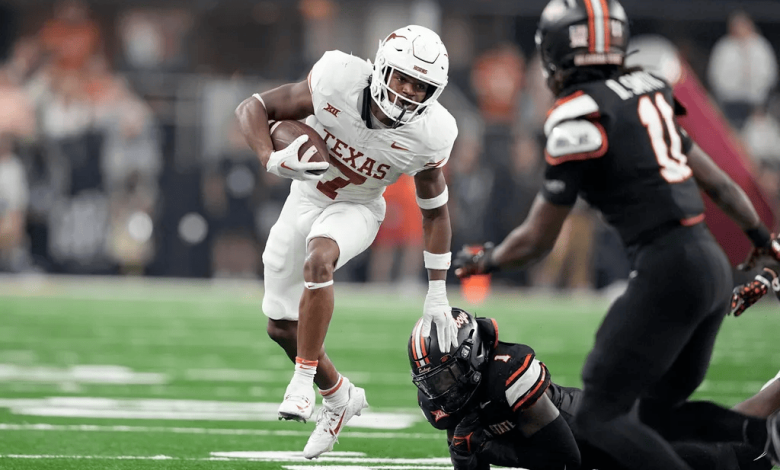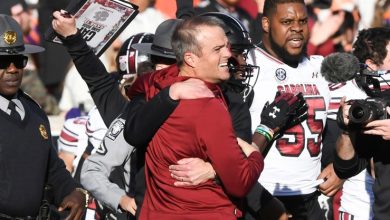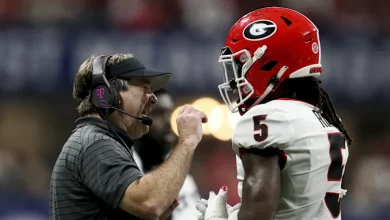Does the current situation of college football stem from Texas and Oklahoma?

College football, in many ways, feels like a sport at a crossroads. With shifting conference alignments, new media deals, and an evolving landscape driven by name, image, and likeness (NIL) rights, the game is unrecognizable from its roots just a couple of decades ago. One of the most significant changes in recent years has been the realignment of conferences—none more consequential than the decision by the University of Texas and the University of Oklahoma to leave the Big 12 and join the Southeastern Conference (SEC).
The announcement, made in 2021, sent shockwaves through the college football landscape, marking the beginning of a larger wave of realignment and signaling the decline of the traditional conference structure that had been in place for decades. Many observers believe that the move by Texas and Oklahoma was the catalyst for much of the current situation in college football—transforming it into a more fragmented, lucrative, and commercialized version of its former self.
In this article, we will examine how the decisions by Texas and Oklahoma to leave the Big 12 and join the SEC have had far-reaching consequences, not just for their respective programs, but for the sport as a whole. From shifting power dynamics and conference rivalries to the eventual rise of superconferences, we will explore the key factors that have contributed to the current situation in college football and whether these changes are ultimately beneficial or detrimental to the game.
The Texas and Oklahoma Decision: A Game-Changer
When Texas and Oklahoma made the announcement that they were departing the Big 12 for the SEC in 2021, the decision was, in many ways, inevitable. For years, there had been murmurs and speculation about the future of the Big 12, especially as other power conferences like the SEC and the Big Ten continued to grow in influence and financial resources. The Big 12, while competitive, had not kept pace with the SEC and the Big Ten in terms of media deals, television contracts, and overall national visibility.
The Texas-Oklahoma move was driven by a number of factors, including:
- Financial Opportunity: The SEC’s media rights deal with ESPN, which includes the lucrative “SEC Network,” had given the conference a financial edge over other leagues. By joining the SEC, Texas and Oklahoma stood to gain significantly from enhanced television exposure and more lucrative bowl game payouts.
- National Exposure and Championship Contention: The SEC, home to some of college football’s biggest powerhouses like Alabama, Georgia, and LSU, offered Texas and Oklahoma a stage to compete for national championships. The SEC’s dominance in the College Football Playoff (CFP) era, with a near-constant presence in the final four, made it an attractive destination for two of college football’s most storied programs.
- Recruiting Power: The SEC is known for its high level of competition and its ability to recruit the nation’s best talent. For both Texas and Oklahoma, being in the SEC gives them the chance to recruit against the best, attracting top-tier athletes who want to compete at the highest level of college football.
- Exposure in the Expanding College Football Playoff: As the College Football Playoff format evolves, more teams will be competing for a spot in the four-team field. Being a part of the SEC, with its consistent success in the playoff, increased Texas and Oklahoma’s chances of competing for national titles.
Texas and Oklahoma’s decision to leave the Big 12 ultimately had seismic repercussions. It set off a chain reaction of realignment, with conferences scrambling to add new members, protect their financial interests, and create stronger television contracts in anticipation of a rapidly changing college football landscape.
Conference Realignment: The Ripple Effects
While the Texas and Oklahoma move was undoubtedly the most high-profile, it wasn’t the only change on the horizon. Their departure from the Big 12 prompted other schools to reconsider their conference affiliations. Soon after the announcement, the Big 12 began its search for replacement schools, eventually adding the University of Cincinnati, Houston, BYU, and Central Florida (UCF) to shore up its membership.
Meanwhile, other power conferences like the Big Ten and the Pac-12 began to explore ways to bolster their own brands and expand their reach. The Big Ten, long seen as one of the most competitive and financially powerful conferences in the country, added the University of Southern California (USC) and the University of California, Los Angeles (UCLA) in 2024—a move that shook the college football world.
As these moves occurred, it became evident that traditional conference rivalries were being disrupted. Schools with deep regional ties—such as Texas A&M’s departure from the Big 12 to the SEC in 2012—were no longer confined to regional rivalries. Instead, the nation’s top programs were increasingly aligning themselves based on the financial and media advantages that certain conferences offered, rather than long-standing geographic relationships.
This shift was amplified by the growing power of television networks, which have become the driving force behind conference realignment. The SEC’s massive television deal, coupled with its exclusive rights to the SEC Network, created a financial divide between the top conferences and the rest of college football. As a result, many programs, including Texas and Oklahoma, made the strategic decision to join conferences that offered the best financial and exposure benefits, even if it meant abandoning old rivalries and regional ties.
The Rise of Superconferences
With Texas and Oklahoma’s move, and the subsequent realignment of conferences like the Big Ten and SEC, college football began to trend toward a future where two or three “superconferences” dominate the sport. This shift raises critical questions about the future of college football: Will the power conferences continue to grow, absorbing smaller programs and leaving traditional conferences like the Pac-12 in the dust? And what will happen to the College Football Playoff as the number of teams in the mix increases?
In many ways, the Texas and Oklahoma move served as the tipping point toward the rise of superconferences. The SEC’s already-dominant position, bolstered by the additions of two marquee programs in Texas and Oklahoma, set the stage for other conferences to follow suit. The Big Ten’s acquisition of USC and UCLA demonstrates that even historically successful programs are no longer immune to the power of media deals and financial incentives.
The transformation of college football into a system dominated by a small number of conferences has sparked debates about fairness, competition, and the future of the sport. While the financial rewards of joining superconferences are obvious, questions remain about the impact on smaller programs, regional rivalries, and the overall health of the game. Will the increasing concentration of power among a few select conferences harm the integrity of college football and its appeal to fans?
Impact on College Football’s Identity and Tradition
One of the most contentious aspects of the Texas and Oklahoma move, and subsequent realignment, is the effect on college football’s tradition and identity. The game has long been celebrated for its regional rivalries, its pageantry, and the deep emotional connections fans have to their local teams and conferences. The regional rivalries that had existed for decades—such as the Red River Rivalry between Texas and Oklahoma—were integral to the fabric of the sport.
With conference realignment, many of these rivalries have been diluted or erased altogether. Texas and Oklahoma’s departure from the Big 12, for example, has shifted the conference’s power dynamic, leaving behind programs with less history and fewer fanbases. Meanwhile, the SEC, Big Ten, and other power conferences continue to add schools that may not have the same regional or historical significance, but whose inclusion is primarily motivated by financial gain and national exposure.
This shift also affects the sense of competition in college football. As the power becomes concentrated in a few select conferences, there is a concern that college football will become more predictable and less inclusive. Will smaller programs have a legitimate shot at competing for national championships, or will the dominant superconferences inevitably push them aside?
The Future of College Football: Will Texas and Oklahoma’s Move Prove to Be the Catalyst?
While the move by Texas and Oklahoma may have been the catalyst for much of the current situation in college football, the ultimate consequences of realignment and the rise of superconferences are still unfolding. It remains to be seen whether the sport will benefit from these changes in the long run, or if the landscape will become so commercialized and fragmented that it loses much of its charm and appeal.
It’s clear, however, that the Texas and Oklahoma move has accelerated trends that were already in motion. The financial rewards of conference realignment, the desire for national exposure, and the drive for competitive supremacy have pushed programs to re-evaluate their affiliations. Whether these changes will create a more exciting and competitive college football landscape or undermine the spirit of the game remains to be seen.
In the end, the current situation in college football is undeniably shaped by the decisions of Texas and Oklahoma. Their move to the SEC, along with the subsequent shifts in conference alignments, has forced college football to confront important questions about fairness, tradition, and the future of the sport. As we look to the future, the continued influence of the SEC, Big Ten, and other power conferences will undoubtedly shape the direction of college football for years to come. Whether these changes will lead to a more competitive and exciting product, or simply accelerate the commercialization of the sport, will be a story worth watching.









